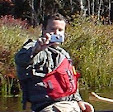 |
| Heading out from the put-in |
The Millers River arises in Auburdale and flows 52-miles to join the Connecticut River in Millers Falls. There are lots of paddling options on the Millers including two sections that are popular for whitewater boating – the Upper Millers from Royalston to Athol (class II/III), and the Lower Millers from Erving to Millers Falls (class II/IV). In between from Athol to Orange is a quickwater section that is the site of the annual spring River Rat Race. Today, we would be paddling the flatwater section above the Birch Hill Dam from Winchendon to Royalston.
 |
| Earl finds some moving water |
For this trip we had four boats – all canoes, and Bob and Dan would be poling. The river was at a nice level with a slight current as we launched and headed downstream. For the first few miles the river twisted and turned though pine forests and swampland.
 |
| Lunch break at King Philip Rock |
We took a break for lunch a little further downstream at King Philip Rock, where Wampanoag sachem Metacomet held tribal councils during King Philip’s War. By now the river had completely disappeared and we were paddling through a large shallow lake filled with trees. From King Philip Rock we paddled through open water over to the beach at Lake Dennison, which is usually connected to the river by a small stream.
 |
| Portaging the Birch Hill Dam |
The Birch Hill Dam is a part of a network of flood control dams on tributaries of the Connecticut River. Completed in 1941, Birch Hill Dam was one of the first dams the Army Corps of Engineers built in New England to prevent floods like those that devastated Athol and Orange in 1936 and 1938. At 14-feet, there was a large pool of water behind the dam, and the take-out at the base of the dam was flooded.
 |
| Paddling the final section to the take-out |
On the way home I decided to check out Doanes Falls on Lawrence Brook - a series of five waterfalls just above Tully Lake. When the Upper Millers is running the waterfalls at Doanes Falls are usually pretty spectacular, and they were. Lawrence Brook feeds into the Tully River, which joins the Millers River in Athol.
Links:



No comments:
Post a Comment
Note: Only a member of this blog may post a comment.